Olympus EVOLT E-500By: Shawn Barnett and Dave Etchells8.0 megapixels, ZUIKO DIGITAL lens mount, digital SLR design, and loads of features! <<Video, Power, Software :(Previous) | (Next): Reference: Datasheet>> Page 14:Test Results & ConclusionReview First Posted: 09/25/2005, Updated: 12/05/2005 |
We ran the Olympus EVOLT E-500 through our usual battery of tests, and have summarized our findings here. To see the full set of our test images, with explanations of what to look for in them, see the Olympus EVOLT E-500 Sample Pictures page. For a complete listing of all our test and "gallery" shots, go to the Thumbnails page.
Not sure which camera to buy? Let your eyes be the ultimate judge! Visit our Comparometer(tm) to compare images from the Olympus EVOLT E-500 with those from other cameras you may be considering. The proof is in the pictures, so let your own eyes decide which you like best!
Lens
Zoom
Good performance with the 14-45mm ZUIKO lens.
| 14mm (28mm equivalent) |
45mm (90mm equivalent) |
The Olympus EVOLT E-500 accommodates a range of Olympus ZUIKO lenses, so performance here will really depend on the lens in use. We shot the above with the 14-45mm ZUIKO lens included with the camera, which produced very good results. (The 40-200mm telephoto furnished with the two-lens kits is also a very nice optic.)
Macro
A slightly large macro area with the kit 14-45mm kit lens, but good detail and resolution. Flash exposes fairly well, but illumination is slightly uneven up close.
| Standard Macro | Macro with Flash |
As with the shots above, results here will completely depend on the lens in use. However, in our testing with a 14-45mm kit lens, the E-500 captured a minimum area of 4.9 x 3.3 inches (124 x 84 millimeters). This isn't spectacular by current standards, but is fairly typical of a non-macro zoom lens. This lens does have front-element filter threads though, so it will be easy to attach add-on macro lenses to get closer. Detail is strong and resolution high, with only moderate softening in the corners from the lens. (Most cameras have some softening in the corners in macro mode.) The E-500's flash throttles down pretty well, though some falloff is visible in the corners of the frame.
Distortion
Higher than average barrel distortion at wide angle, just a small amount at telephoto.
This is the tendency for the lens to bend straight lines outward (like a barrel--usually at wide angle) or inward (like a pincushion--usually at telephoto). The 14-45mm lens included with the E-500 produced 0.9% barrel distortion at wide angle, a bit higher than average among the digital cameras we test. At the telephoto end, the lens produced about 0.07% barrel distortion, which is low.
| Barrel distortion at 14mm is 0.9% |
| Barrel at 45mm is 0.07% |
Chromatic aberration
Very low, small effect on images at edges.
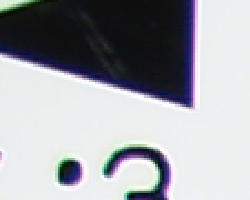 |
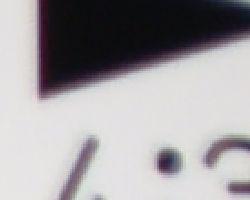 |
| Wide: moderate, top left @ 200% | Tele: very low, top right @200% |
Chromatic aberration in the 14-45mm kit lens is moderate at wide angle, showing about 3-4 fairly bright pixels of coloration on either side of the target lines, but decreases to much lower levels at telephoto focal lengths. (This distortion is visible as a very slight colored fringe around the objects at the edges of the field of view on the resolution target.)
Corner Sharpness
Some blurring in the corners, but results improve a fair bit when stopped down.
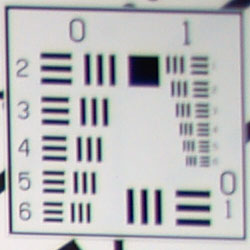 |
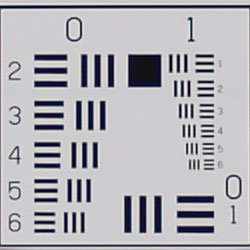 |
| Wide Angle: Rather soft in the upper right corner. |
Wide Angle: Center, for reference. |
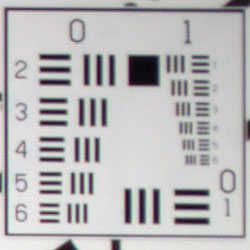 |
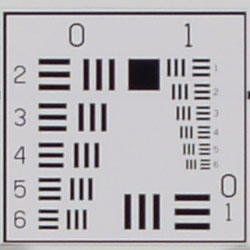 |
| Tele: Also soft in the upper right corner. |
Tele: Center, for reference. (Just slightly softer) |
Wide open (as in the shots above), the E-500's lens showed noticeable softening in the corners of the frame, the upper right corner being the worst. Thankfully, this softness decreases markedly when you decrease the aperture just one stop. Performance overall is similar to the kit lenses offered with other entry-level digital SLRs.
Viewfinder
Coverage
Good accuracy with the optical viewfinder.
| 14mm eq., optical viewfinder | 45mm eq., optical viewfinder |
The E-500's optical viewfinder proved fairly accurate, showing about 96% frame accuracy at wide angle and about 95% at telephoto. This is about average for digital SLRs, as most show about 95% of the frame.
Color
Saturation & Hue Accuracy
Good overall color and hue accuracy.
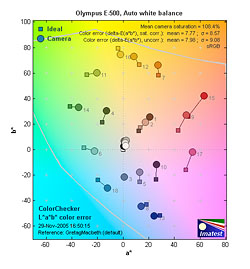 |
| In the diagram above, the squares show the original color, and the circles show the color that the camera captured. More saturated colors are located towards the periphery of the graph. Hue changes as you travel around the center. Thus, hue-accurate, highly saturated colors appear as lines radiating from the center. |
The other important part of color rendition is hue accuracy. Hue is "what color" the color is. Here, the E-500 also performed well. It does shift cyan colors toward blue (for better-looking sky colors) and magenta colors are shifted toward red a fair bit, but the rest of the hues were fairly accurate.
Sensor
Exposure and White Balance
Indoors, incandescent lighting
Good results with the Manual white balance setting, Incandescent and 2900K white balance settings also good, Auto quite warm-toned. Much higher exposure compensation required than usual.
| Auto White Balance +1.7 EV | Incandescent WB +1.7 EV |
| Manual White Balance +1.7 EV | 2,900 Kelvin WB +1.7 EV |
The E-500's Manual white balance setting did the best job under the incandescent lighting of this shot, producing an image that was very faithful to the original lighting. The 2,900 Kelvin and Incandescent settings also did quite well, although they both produced slight pinkish casts, while the Auto setting resulted in a very yellowish image. The camera required a hefty +1.7 EV exposure compensation boost to get a good exposure, much higher than average for this shot. (The E-500 does seem a little overly sensitive to large highlight areas near the center of the frame.) Color with the Manual white balance setting is just slightly yellowish (nicely suggesting the warmth of the original lighting, without being overpowering), but the scene colors are still pretty good. However, the blue flowers are very dark and purplish and Marti's skin tone is fairly pink. (Very common outcome for this shot.) Our test lighting for this shot is a mixture of 60 and 100 watt household incandescent bulb, a rather yellow light source, but a very common one in typical home settings here in the US.
Outdoors, daylight
Good color balance in most cases, though slightly warm with Auto white balance. Good exposure accuracy.
| Auto White Balance, +0.7 EV | Auto White Balance, Auto Exposure |
The E-500's outdoor shots were generally pretty accurate exposure-wise, though with somewhat high contrast and blown-out highlights. (The camera's contrast adjustment helped slightly, but could really stand to go further in the low-contrast direction.) Deep shadows were pretty dark, but still held onto good detail, and the camera typically required less exposure compensation than average outdoors.
See full set of test images with explanations
See thumbnails of all test and gallery images
Resolution
Very high resolution, 1,450 lines of strong detail.
Our laboratory resolution chart revealed sharp, distinct line patterns down to about 1,450 lines per picture height, with extinction at around 2,000. (The camera did produce a few slight color artifacts at lower line frequencies though, visible in the full-sized res target shots.) One could easily argue for higher resolution numbers, but we felt that the level of color artifacts that began to appear higher than 1,450 lines was such that a higher rating really wouldn't be consistent with our test standards.) Use these numbers to compare with other cameras of similar resolution, or use them to see just what higher resolution can mean in terms of potential detail.
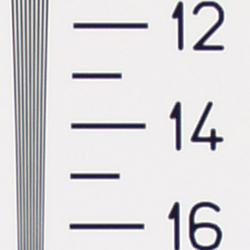 |
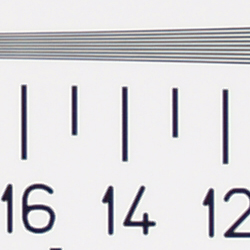 |
| Strong detail to 1,450 lines horizontal | Strong detail to 1,450 lines vertical |
See full set of test images with explanations
See thumbnails of all test and gallery images
Sharpness & Detail
Fairly good fine detail, but some coarseness from in-camera sharpening. Only slight blurring at low ISO from noise suppression in shadow areas.
The E-500's images are show a lot of detail overall, but the camera's sharpening algorithms tend to coarsen the very finest detail somewhat. (Edge enhancement creates the illusion of sharpness by enhancing colors and tones right at the edge of a rapid transition in color or tone.) In the detail crop above right, you can see a slight "halo" around the branches against the sky. The finest details are just a tad bulkier than in real life, and the presence of the sharpening halos precludes much improvement with unsharp masking on the computer after the fact.
Noise-suppression systems in digital cameras tend to flatten-out detail in areas of subtle contrast. The effects can often be seen in shots of human hair, where the individual strands are lost and an almost "watercolor" look appears in areas where the contrast between hair strands is low. The crop at right above shows this to a slight extent in the lower midtones, but it isn't as pronounced as we've seen in some cameras.
ISO & Noise Performance
Low noise at the low sensitivity settings, and pretty good results as high as ISO 800. However, very high noise with blurred detail at the highest setting of ISO 1600.
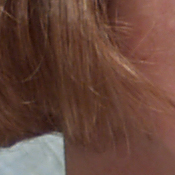 |
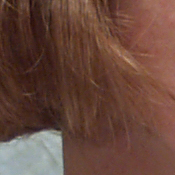 |
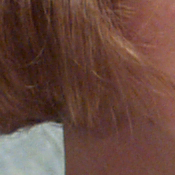 |
| ISO 100 | ISO 200 | ISO 400 |
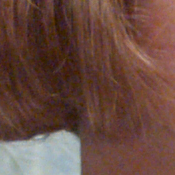 |
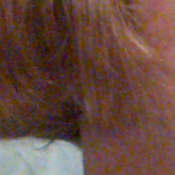 |
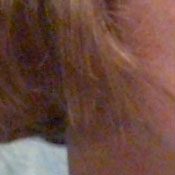 |
| ISO 800 | ISO 1,600 | ISO 1,600 w/NR |
The E-500's lower ISO settings produced low noise, with only slightly blurred detail in the dark areas. Even at ISOs 400 and 800, while noise is a little higher, detail definition remains pretty good. At ISO 1,600, though, noise is very high, quite noticeable in 8x10 inch prints, and even 5x7 inch prints are a little marginal. The noise reduction menu option does help matters quite a bit (more apparent in prints than on-screen), at the cost of some additional loss of detail.
Extremes: Sunlit and low light tests
Some tendency to lose highlight detail under harsh lighting. Very good low-light performance, capable of capturing bright images under average city street lighting and much darker conditions.
| +0.3 EV | +0.7 EV | +1.0 EV |
Sunlight:
Because digital cameras are more like slide film than negative film (in that they tend to have a more limited tonal range), we test them in the harshest situations to see how they handle scenes with bright highlights and dark shadows, as well as what kind of sensitivity they have in low light. The shot above is designed to mimic the very harsh, contrasty effect of direct noonday sunlight, a very tough challenge for most digital cameras. (You can read details of this test here.)
The E-500 did fairly well under the deliberately harsh lighting in the test above, but did lose more highlight detail than I'd like to see, even with its contrast control at the low setting. Still, the highlights on Marti's forehead are held in check, even though detail is lost in her shirt, and shadow detail is good, if not a little noisy. An exposure boost of +0.7 EV was just enough to brighten the overall image, without going too far and blowing out the highlights too much. (In "real life" though, be sure to use fill flash in situations like the one shown above; it's better to shoot in the shade when possible.)
Low light:
The E-500 performed well here, and captured bright, usable images even at the lowest light levels we test at. With its adjustable ISO and maximum shutter time of 30 seconds, the E-500 is well-equipped for low-light shooting. The E-500's autofocus system is also capable of focusing in very dim lighting, provided that the camera and subject are both absolutely motionless. (Like most digital cameras, the E-500 is going to have a hard time focusing on moving subjects in low light, a situation where you'll be better off relying on a preset manual focus if at all possible.) It focused down to a bit under 1/8 foot-candle even with its AF illuminator turned off, and in complete darkness on nearby objects with the AF illuminator enabled. Color balance was a little warm with the Auto white balance setting, though some shots showed a slight pink cast. Noise is fairly low, even without Noise Reduction enabled. At 1,600 ISO, noise is on the high side, but is still good considering the high sensitivity setting.
Flash
Coverage and Range
Good flash capability, but a bit uneven at maximum wide angle with the kit 14-45mm lens. Our standard shots required more exposure compensation than average.
| 14mm equivalent | 45mm equivalent |
| Normal Flash +1.7 EV | Slow-Sync Flash +1.0 EV |
With the 14-45mm kit lens, flash coverage was rather uneven at wide angle, much more uniform at telephoto. In the Indoor test, the flash on the E-500 underexposed our subject at its default setting, requiring a +1.7 EV exposure compensation adjustment to get bright results. Most cameras underexpose this shot by about a full f-stop, so the E-500's +1.7 EV adjustment is a fair bit higher than most. In the Slow-Sync flash mode, the camera only required a +1.0 EV exposure boost, but coverage appears about the same.
| 8 ft | 9 ft | 10 ft | 11 ft | 12 ft | 13 ft | 14 ft |
1/80 sec f5.6 ISO 100 |
1/80 sec f5.6 ISO 100 |
1/80 sec f5.6 ISO 100 |
1/80 sec f5.6 ISO 100 |
1/80 sec f5.6 ISO 100 |
1/80 sec f5.6 ISO 100 |
1/80 sec f5.6 ISO 100 |
The E-500's built-in flash illuminated the test target all the way to 14 feet with fairly consistent intensity, though results were slightly dim overall.
Output Quality
Print Quality
Good print quality, nice color. Prints at 13x19 are a little soft if viewed closely, but look great at normal viewing distances. High ISO (1600) is rough at 8x10 inches, but noise reduction helps quite a bit, albeit with some cost in sharpness.
Testing hundreds of digital cameras, we've found that you can only tell just so much about a camera's image quality by viewing its images on-screen. Ultimately, there's no substitute for printing a lot of images and examining them closely. For this reason, we now routinely print sample images from the cameras we test on our Canon i9900 studio printer, and on the Canon iP5000 here in the office. (See the Canon i9900 review for details on that model.)
With 8 megapixels of resolution and decent optics, the Olympus E-500 produces great looking prints as large as 13x19. At that size, if you squint at them close up, they look a little soft/coarse/heavy, likely from the slightly heavy-handed in-camera sharpening we commented on earlier. Interestingly though, if you step back and look at them at more normal viewing distances for prints that size (say a foot or so), the give an entirely different impression of excellent sharpness. - It seems that the sharpening we've been criticizing as being heavy-handed is actually tuned very well to typical print sizes and viewing distances.
High ISO shots seem to be the E-500's Achilles' heel though, as noise is quite apparent in ISO 1600 shots printed at 8x10 inches. The menu option for additional high-ISO noise reduction does make a very visible difference in apparent noise levels at ISO 1600, albeit at some additional cost in lost sharpness. ISO 1600 shots do look much better when printed at 5x7, especially if the noise reduction system is engaged. Overall, the E-500 is quite usable at ISO 1600, but isn't in the same league as cameras like the Canon Digital Rebel XT for such application.
Timing and Performance
Olympus EVOLT E-500 Timing
Slightly slow for a digital SLR.
|
Startup/Shutdown:
|
|
|
Power On to first shot
|
3.0 seconds
|
|
Shutter response (Lag Time):
|
|
| Full Autofocus Wide |
0.37 second
|
| Full Autofocus Tele |
0.38 second
|
| Prefocused |
0.095 second
|
|
Cycle time (shot to shot)
|
|
|
Normal large/fine JPEG
|
0.90 second
|
|
Flash recycling
|
5.0 seconds
|
|
Continuous mode
|
0.39 second
2.58 frames/second (4 large/fine frames) |
|
Download speed
|
|
|
Windows Computer, USB 2.0
|
676 KBytes/sec
|
The Olympus E-500's performance ranges from average to a bit slower than average, depending on what you're trying to do. Startup time is a little slow for an SLR at 3.0 seconds, but keep in mind that camera is performing its Supersonic Wave Filter operation, which many might argue is a worthwhile wait. Shutter lag is good at both wide angle and telephoto, and gets very fast when the camera is prefocused (when the shutter button is halfway pressed and held prior to the shot). Shot to shot cycle times are acceptable but by no means category-leading, at about 0.9 seconds for large/fine JPEGs, though Continuous-mode speed is average, at about 2.58 frames/second, but a smallish buffer memory limits you to bursts of only four large/fine JPEG images at that speed. The flash takes about five seconds to recharge after a full-power shot, also slightly slow for an SLR. Connected to a computer, download speeds are fast enough that you shouldn't feel a need for a separate card reader, but nonetheless aren't as fast as many cameras currently on the market.
Battery and Storage Capacity
Battery
Typical (good) battery life for a digital SLR.
The Olympus E-500 uses a custom rechargeable LiIon battery for power. Because it doesn't have a standard external power connector, we weren't able to conduct our usual power consumption tests on it. Like most digital SLRs though, the E-500 boasts excellent battery life, because it isn't dependent on the sensor and LCD for framing shots. Olympus rates the E-500's battery life at about 500 shots per charge in typical usage. If you plan to do a lot of "chimping" (looking at your photos on the LCD screen in playback mode) or expect to shoot more than 500 shots in a single outing, you'll want to get a second battery along with the camera, but for most day to day usage, a single battery should be sufficient.
Storage
No card is included with the Olympus EVOLT E-500, but it accepts both CompactFlash and xD-Picture Cards.
| 256MB Memory Card |
Fine | |
| 3,264 x 2,448 | Images | 40 |
| File Size | 6.3MB | |
| 3,200 x 2,400 | Images | 42 |
| File Size | 6.1MB | |
| 2,560 x 1,920 | Images | 62 |
| File Size | 4.1MB | |
| |
Images | 179 |
| File Size | 1.4MB | |
| |
Images | 274 |
| File Size | 933K | |
| |
Images | 419 |
| File Size | 611K | |
| |
Images | 995 |
| File Size | 257K | |
We strongly recommend that you buy a large capacity CompactFlash memory card, at least 512 MB, and preferably a full gigabyte, to give you ample space for extended shooting sessions.
| Pro: | Con: |
|---|---|
|
|
| Free Photo Lessons | |
|
The Olympus E-500's combination of very extensive Scene modes with full-featured exposure and creative control suit it to situations where both novice and experienced shooters need to share the same camera. While easy enough for pure novices to use in its fully automatic "green zone" mode, the E-500's more advanced exposure options will also be appealing to more experienced digital photographers, as it's arguably the most configurable camera anywhere close to its price class.
The camera itself is priced quite competitively, but the bundled kit consisting of the camera body and Olympus 14-45mm and 40-150mm lenses make for a bargain that's just unbeatable in the current market. (This review is being written in late November, 2005) The availability of high-quality, affordable lenses is important to any entry-level SLR, and this has been addressed both by Olympus themselves in the form of the two lenses just mentioned, as well as by third-party lens maker Sigma, who now has an extensive and growing line of Four Thirds-compatible lenses available.
The E-500's image quality is generally quite good, with pleasing color and image noise matching that of the competition at all but its highest ISO setting. If you're shopping for a digital SLR, and don't already own a bagful of Canon or Nikon lenses, the Olympus E-500 EVOLT deserves a very close look indeed. It will be interesting to see how the E-500 fares in the market, but our prediction is that its going to be one of the hottest SLRs going, both in the upcoming holiday season and throughout 2006 as well. Highly recommended, and one of the standout bargains in the entire SLR field.
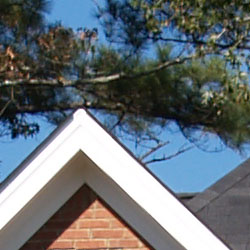



Follow Imaging Resource: